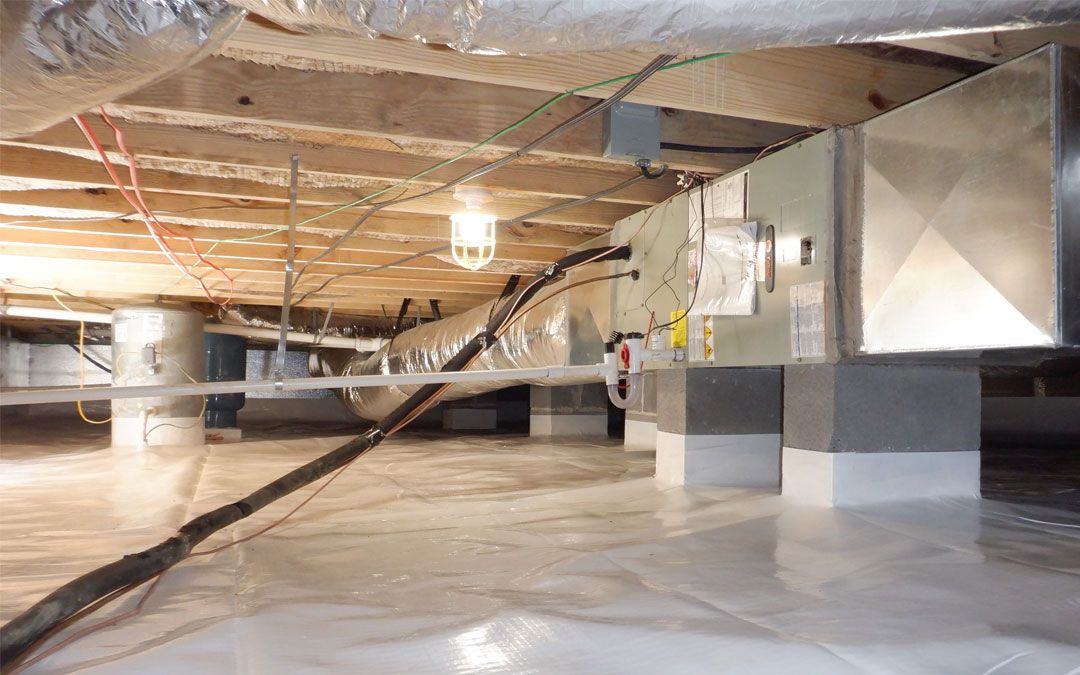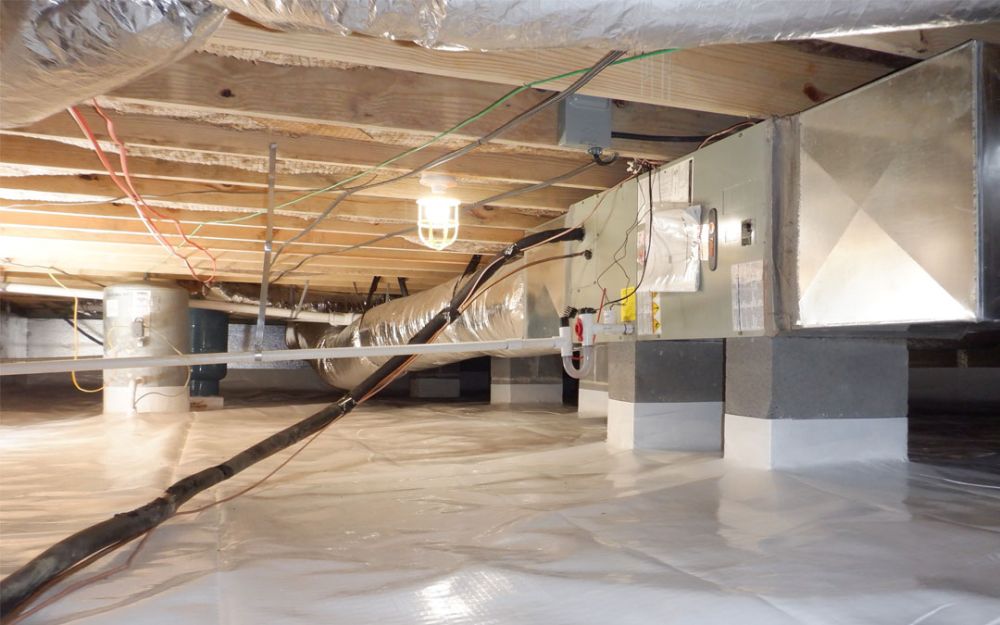Crawl Space Moisture Control: 5 Tips to Help Keep Your Home Safe



Most homeowners don’t think about crawl space moisture control until they see signs of excess moisture in their homes. Unfortunately, not only can excess humidity lead to dangerous mold growth, but it can also cause damage to your home’s structure over time.
Keeping moisture levels in your home healthy is essential for various reasons. So keep reading as we discuss five tips for crawl space moisture control and how to keep your home safe and healthy!
For crawl space moisture control in the greater Hampton Roads, VA / NC region, learn more about BAY Crawl Space & Foundation Repair at our Home Page, About Us Page, or Request A Free Quote Page.
What Happens Without Crawl Space Moisture Control?
When moisture accumulates in the home, it can create various problems. For example, excess moisture can lead to mold growth linked to health issues such as asthma, allergies, and even respiratory illnesses.
In addition, moisture levels that are higher than normal can cause wooden floors and furniture to warp over time. It can also cause paint to peel and walls to develop moisture spots.
It’s essential to monitor the moisture levels in your home and take proactive measures to ensure that it stays within a healthy range. Here are five tips for crawl space moisture control:
1. Install a Dehumidifier
A dehumidifier is key to controlling moisture in your crawl space. But first, it is essential to note that you should keep the humidity levels of a crawl space below 65%. Doing this will not only prevent mold and mildew from forming, but it will also protect you from dangerous allergens such as dust mites.
Installing a dehumidifier is an easy way to maintain these humidity levels. In addition, it can help reduce energy costs by reducing the need to run other air conditioning systems in your home.
First, you will need to assess the size of your crawl space to determine what type & quantity of dehumidifier you will need. Larger homes may require a larger unit or multiple units, while smaller crawl spaces only need a small-capacity dehumidifier. Consider the features offered by the dehumidifier before making a decision.
Once you have chosen the right dehumidifier for your space, it is time to install it. To ensure optimal performance, you should regularly clean or replace the filters in your dehumidifier.
With proper maintenance, your dehumidifier should last many years and help improve the air quality in your home. Investing in a dehumidifier is an easy and effective way to control moisture in your crawl space.
2. Check for Leaks
Have you ever taken a look inside your crawl space? It’s dark, damp, and filled with unknown crevices and corners. A crawl space is a place most of us try to avoid at all costs – but it should be one of the first places on your property that gets checked for moisture problems.
Crawl spaces are often overlooked when it comes to moisture control. However, they can be one of the most common sources of household leaks and water damage. Moisture is due to their exposed location below ground and outside the home, making them easy targets for floods or other water events.
If you’ve noticed a musty smell or signs of mold in your basement, there may be an underlying moisture problem in your crawl space. In order to check for leaks, it’s crucial to inspect the walls and floor of the crawl space for any signs of water damage or increased humidity levels.
Once you’ve located the source of the leak, it’s time to take action. First, caulk cracks and seal off any gaps that could be allowing water to enter the crawl space. Then, if necessary, you may need to install a sump pump or other drainage system to keep water away from your home.
Taking care of moisture issues in your crawl space right away can protect your home and save you time and money in the long run. So don’t forget to check for water in your crawl space – it could be the difference between a safe, dry home and an expensive repair job.
3. Improve Ventilation
Good ventilation is a must for any homeowner. Without proper ventilation, moisture builds up, leading to mold and mildew growth, unpleasant odors, and unsightly water stains on walls and ceilings. Not only is this an eyesore, but it can also lead to serious health risks if not treated properly.
But why should you care about improving your crawl space ventilation? Well, your crawl space is your home’s foundation, and if it’s not adequately vented, all that moisture can seep into your living space. Not only does this lead to mold, but it can also cause weakened structures and even potential flooding.
The good news is that you can prevent all these problems by improving your crawl space’s ventilation. You’ll need adequate air circulation and proper drainage for any water that does get in. Start by evaluating the current condition of your crawl space and then take steps to increase ventilation by installing dehumidifiers with fans or other devices designed specifically for this purpose.
Improving your home’s ventilation can help keep moisture away and protect your family from potential health hazards. So remember to check the ventilation in your crawl space – it could be the difference between a safe, healthy home and costly repairs down the line.
4. Improve Insulation
Insulating your home is vital for keeping moisture out and improving energy efficiency. But what about insulation in the crawl space?
Insulating your crawl space is essential for preventing moisture problems, as it creates a barrier between the outdoors and your home. Doing this helps limit how much moisture can enter through walls and floors and can also help keep temperature levels stable throughout your home.
There are a few different materials to choose from when insulating your crawl space. Cellulose insulation, for example, is moisture-resistant and can act as a moisture barrier.
However, suppose moisture is a concern in your area. In that case, consider using rigid foam board insulation instead. This type of insulation is moisture-resistant and can provide a better moisture barrier.
No matter which type of insulation you choose, install it properly and keep an eye on moisture levels in the crawl space. By insulating your home correctly, you can ensure that moisture stays out and your family stays safe.
5. Keep Gutters Clean
Gutters are often overlooked when preventing moisture in crawl spaces, but they play an essential role. Leaves and debris that accumulate in gutters can clog them and prevent the proper flow of rainwater away from your home. That leads to a wet crawl space, mold growth, and other problems.
In order to help prevent moisture buildup in your crawl space, it is essential to keep gutters clean and free of debris. Otherwise, the water can back onto the roof, creating issues with pooling on the ground below, including your foundation and crawl space.
Thankfully, cleaning out your gutters is relatively easy and convenient. You can use a bucket or a garden hose with an attachment to remove any debris from your gutters.
If you have access to a power washer, that can also work. Check the downspout as well since it’s likely to get clogged up.
It is recommended that you clean your gutters at least a few times each year, but more often if you live in an area that receives significant rain. That is because debris can accumulate quickly. In addition, the water may flow faster during heavy rains and cause clogs to form very soon.
By keeping your gutters clean and free of debris, you can help to prevent moisture buildup in your crawl space, which may lead to serious issues. Take the time to inspect and clean out your gutters for optimal results regularly.
Indications of Excess Moisture in Your Home
Once moisture starts to build up in your home, there are several signs that you should be aware of. One of the most common is a musty odor, which can indicate the presence of mold or mildew. Additionally, visible condensation on windows and walls may indicate too much moisture in the air.
You may also notice wood rot or discoloration on walls and floors, which can be caused by moisture from outside. This can become a serious problem if left untreated, as it will weaken the structure of your home over time. Finally, you may experience increased irritations, such as sneezing or coughing, due to moisture-related allergens in the air.
If you notice any of these signs, it is vital to address moisture issues in your home as soon as possible. Taking moisture control seriously can help keep your family safe and prevent further damage from moisture buildup.
Crawl Space Moisture Control Solution: Crawl Space Encapsulation
Crawl space moisture control can be daunting, but you can help keep your home moisture-free with the right approach. From proper insulation and ventilation to gutter maintenance and moisture detection, you must address various tasks to prevent moisture from damaging your home.
Thankfully, BAY Crawl Space in Norfolk, VA, provides crawl space encapsulation services that help keep humidity out of your home and protect it from further damage.
Moisture control can help maintain your home’s integrity and keep your family safe. Contact BAY Crawl Space at (757) 460-0444 to request a free expert inspection today!

